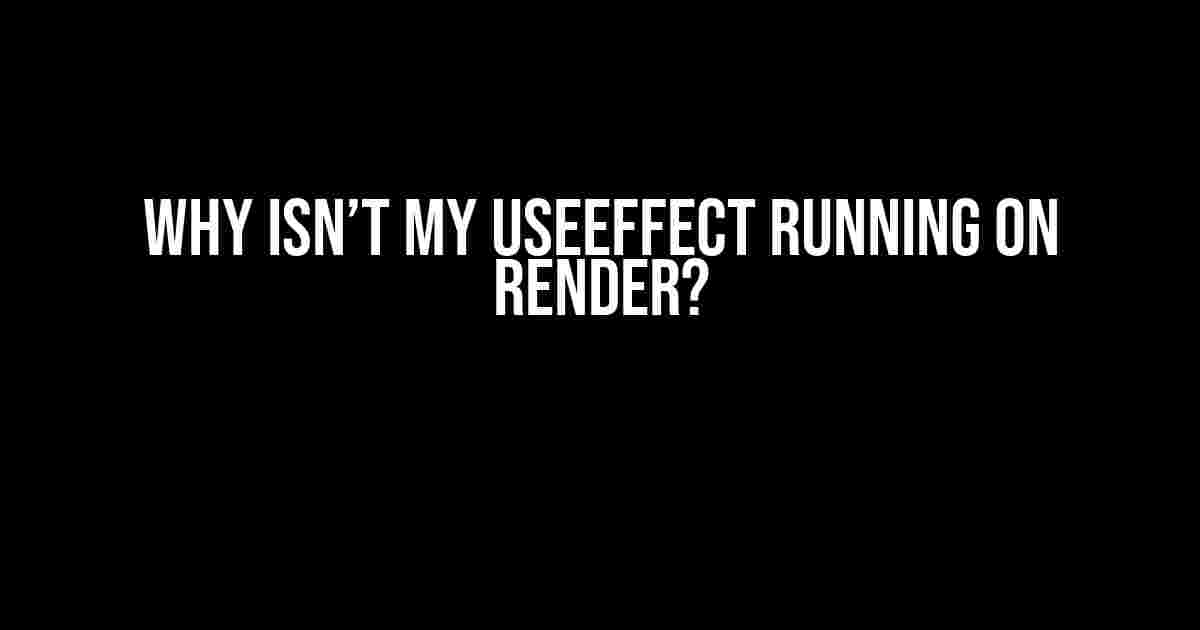If you’re reading this, chances are you’re pulling your hair out trying to figure out why your useEffect hook isn’t running when you expect it to. Don’t worry, friend, you’re not alone! In this article, we’ll dive into the world of useEffect and explore the most common reasons why it might not be running on render. So, grab a cup of coffee, sit back, and let’s get started!
What is useEffect, anyway?
Before we dive into the troubleshooting process, let’s take a quick refresher on what useEffect is and how it works. useEffect is a hook that allows you to run side effects in functional components. It’s like a special function that gets called after every render, giving you the chance to update the DOM, fetch data, or perform any other action that requires access to the DOM.
import { useState, useEffect } from 'react';
function MyComponent() {
const [count, setCount] = useState(0);
useEffect(() => {
// This is where the magic happens!
}, [count]);
return (
Count: {count}
);
}
The Most Common Reasons Why useEffect isn’t Running on Render
Now that we’ve got a brief understanding of useEffect under our belts, let’s explore the top reasons why it might not be running when you expect it to.
Reason #1: Missing Dependency Array
One of the most common mistakes is forgetting to include the dependency array in the useEffect hook. The dependency array tells React when to re-run the effect. If you don’t include it, the effect will only run once, on the initial render.
useEffect(() => {
// This will only run on the initial render!
});
To fix this, simply add an empty dependency array if you want the effect to run only on the initial render, or include the dependencies that should trigger the effect to re-run.
useEffect(() => {
// This will run on every render!
}, []);
useEffect(() => {
// This will run whenever `count` changes!
}, [count]);
Reason #2: Incorrect Dependency Array
Sometimes, you might include the wrong dependencies in the array, or forget to include them altogether. This can cause the effect to run unnecessarily or not at all!
For example, if you’re using a function as a dependency, make sure it’s wrapped in a useCallback hook to prevent infinite re-renders.
import { useState, useEffect, useCallback } from 'react';
function MyComponent() {
const [count, setCount] = useState(0);
const fetchData = useCallback(() => {
// Fetch data from API
}, [count]);
useEffect(() => {
fetchData();
}, [fetchData]);
return (
Count: {count}
);
}
Reason #3: useEffect Runs on Every Render (But You Don’t Want It To)
By default, useEffect runs on every render, which can be performance-heavy if you’re performing expensive operations. To optimize this, you can use the `useEffect` hook with an empty dependency array to run the effect only on the initial render.
useEffect(() => {
// This will only run on the initial render!
}, []);
If you need to run the effect on every render, but with some conditions, you can use the `useRef` hook to create a flag that tracks whether the effect should run or not.
import { useState, useEffect, useRef } from 'react';
function MyComponent() {
const [count, setCount] = useState(0);
const didMount = useRef(false);
useEffect(() => {
if (didMount.current) {
// Run the effect only if the component has already mounted
console.log('Running effect!');
} else {
didMount.current = true;
}
}, [count]);
return (
Count: {count}
);
}
Reason #4: useEffect isn’t Running Because of a Memoization Error
Memoization is a technique to optimize performance by caching the results of expensive function calls. However, if you’re using a memoized function as a dependency in the useEffect hook, it might not run as expected.
import { useMemo } from 'react';
function MyComponent() {
const data = useMemo(() => {
// Expensive function call
return fetchApiData();
}, []);
useEffect(() => {
console.log(data); // This might not run because of memoization!
}, [data]);
return (
Data: {data}
);
}
To fix this, make sure to include the `useMemo` function in the dependency array, like so:
import { useMemo } from 'react';
function MyComponent() {
const data = useMemo(() => {
// Expensive function call
return fetchApiData();
}, []);
useEffect(() => {
console.log(data); // This should run now!
}, [data, useMemo]);
return (
Data: {data}
);
}
Reason #5: You’re Using a Third-Party Library that Interferes with useEffect
Sometimes, third-party libraries can interfere with the useEffect hook, causing it to not run as expected. This is often due to the library using its own custom hooks or modifying the React context.
To troubleshoot this, try removing the library or checking the library’s documentation for any known issues with useEffect. You can also try using the `useEffect` hook with the `flushSync` option to force the effect to run synchronously.
import { useEffect, flushSync } from 'react';
useEffect(() => {
flushSync(() => {
// Run the effect synchronously
});
}, []);
Conclusion
And there you have it, folks! The top reasons why your useEffect hook might not be running on render. By following these troubleshooting steps, you should be able to identify and fix the issue in no time.
Remember, useEffect is a powerful tool that requires careful consideration of its dependencies and usage. With practice and patience, you’ll become a master of useEffect and be able to tackle even the most complex React applications.
Bonus: Debugging useEffect with the React DevTools
Did you know that the React DevTools provide a wealth of information to help you debug your useEffect hooks? Let’s take a quick peek!
- Open the React DevTools in your browser.
- Select the “Components” tab.
- Find the component that contains the useEffect hook.
- Click on the “Hooks” tab.
- Look for the useEffect hook in the list.
- Click on the “Dependencies” tab to view the dependency array.
- Click on the “Calls” tab to view the number of times the effect has run.
By using the React DevTools, you can gain valuable insights into how your useEffect hook is running and troubleshoot issues more efficiently.
| Troubleshooting Step | Description |
|---|---|
| Check for missing dependency array | Make sure to include the dependency array in the useEffect hook. |
| Verify correct dependencies | Ensure that the dependencies in the array are correct and up-to-date. |
| Optimize useEffect for performance | Use an empty dependency array or a useRef hook to optimize the effect. |
| Check for memoization errors | Make sure to include memoized functions in the dependency array. |
| Investigate third-party library interference | Check if the library is causing issues with the useEffect hook. |
We hope this article has helped you troubleshoot and fix those pesky useEffect issues. Happy coding, and remember: with great power comes great responsibility!
Here are 5 Q&A about “Why isn’t my useEffect running on render?” :
Frequently Asked Question
Having trouble with your useEffect hook? Don’t worry, we’ve got you covered! Here are some common reasons why your useEffect might not be running on render.
Is my useEffect dependency array empty?
If your dependency array is empty, your useEffect will only run once on mount and not on subsequent renders. Make sure to add the necessary dependencies to the array to trigger the effect on every render.
Am I using the correct hook syntax?
Double-check your useEffect syntax! Ensure you’re using the correct hook syntax, including the square brackets and the function inside. A simple mistake can prevent your useEffect from running.
Is my component being re-rendered?
If your component isn’t being re-rendered, your useEffect won’t run. Check if your component is receiving updates or if the state is changing. If not, your useEffect won’t be triggered.
Am I using a stale closure?
A stale closure can prevent your useEffect from running. Make sure you’re not capturing a stale value from a previous render. Use the `useCallback` hook or memoize the function to ensure you’re getting the latest value.
Is my useEffect being blocked by another effect?
If you have multiple useEffect hooks, they might be blocking each other. Check if another effect is overriding your useEffect. Use the `useEffect` hook with the `cleanup` function to ensure the previous effect is cleaned up before running the next one.



